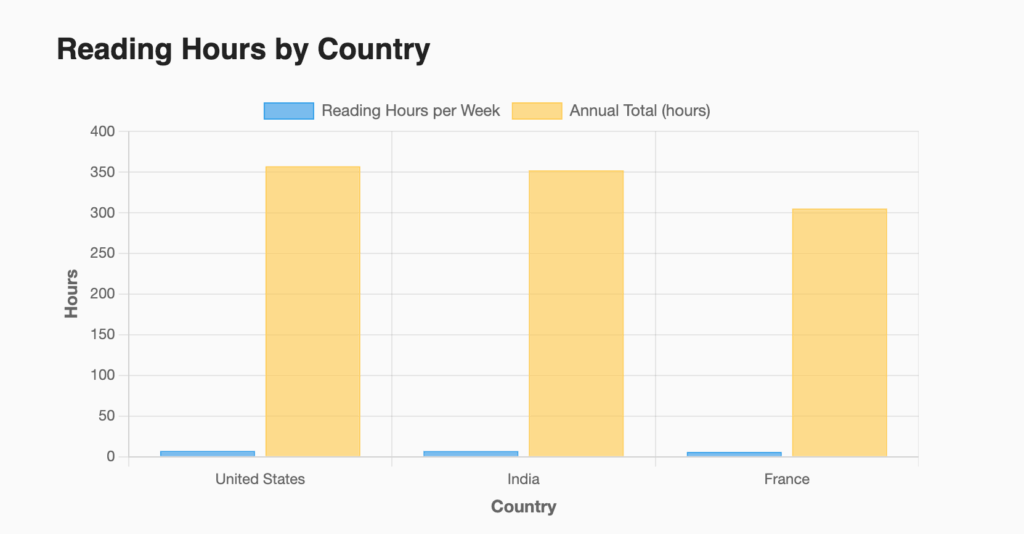The Most Important Reading Statistics and Insights You Should Know

Reading shapes how people learn, communicate, and understand the world. From early childhood through adulthood, reading habits influence educational outcomes, cultural exchange, and personal development. Yet these habits are constantly shifting in response to technology, media consumption, and global literacy trends. To understand these changes, it helps to look at the numbers behind them.
Table of Contents
Why Reading Statistics Matter
Reading remains one of the most powerful tools for learning, but how people engage with it is changing rapidly. Examining reading stats offers a clearer view of how societies adapt to technological shifts, changing cultural habits, and evolving education systems. Policymakers use these numbers to shape literacy initiatives, educators rely on them to adapt curricula, and publishers track them to anticipate new trends. Beyond policy, there are plenty of fun facts about reading that reveal how individuals interact with texts in ways previous generations did not.
Looking closely at literacy patterns across age groups and regions exposes surprising gaps and opportunities. Some populations are reading more than ever, while others are turning away from traditional reading altogether. These shifts have significant consequences for education, communication, and personal development.
Global Reading Statistics
On a global scale, the adult literacy rate has reached 86.3%, but over 750 million people still lack basic literacy skills, most of them women, according to UNESCO. Two centuries ago, only around 12% of the world’s population could read; today, that figure is almost completely reversed. The rise in literacy has been accompanied by variations in reading time across countries.
| Country | Reading Hours per Week | Annual Total |
|---|---|---|
| United States | 7 hours | 357 hours |
| India | 6.8 hours | 352 hours |
| France | 5.8 hours | 305 hours |

The data, published by World Population Review, highlights the role of cultural and educational environments. In some regions, communal reading traditions and library systems encourage daily engagement, while in others, reading happens mainly during specific seasons. Reading statistics in America show that participation spikes during holidays and summer reading initiatives, balancing out the overall yearly averages.
Reading Habits Among Students
For students, reading is both a learning necessity and a personal choice. A national survey by the Literacy Trust found that only 32.7% of children aged 8-18 in the UK enjoy reading, and just 18.7% read daily for pleasure. These numbers reveal a widening gap between required and voluntary reading. Students who follow structured reading programs typically finish significantly more books each year than peers without such support, demonstrating the role that consistent frameworks play in sustaining reading habits.
The behaviors shaping student reading can be summarized as follows:
- Increasing reliance on short-form content such as summaries and quick overviews.
- Using digital reading primarily during class, then shifting to social media afterward.
- Preferring printed books for deep study despite strong digital literacy.
These trends mirror reading statistics for students in many countries, showing that engagement levels often reflect the way schools frame reading within their curricula.
Digital Reading and Technology
Technology has redefined how people interact with texts. Pew Research Center reports that 64% of U.S. adults read at least one book in the past year, in any format, but print still leads. Meanwhile, data from the National Endowment for the Arts shows that only 48.5% read at least one book in 2022, indicating a gradual decline in traditional reading habits.
Digital reading platforms offer accessibility and customization, yet they can also encourage fragmented attention. Studies have shown that gamified reading apps improve retention by up to 75% compared to control groups. These tools rely on streaks, goals, and rewards to keep readers returning. Still, digital reading alone cannot guarantee comprehension. When students are overloaded, many choose a research paper writing services to manage analytical assignments rather than fully engaging with the texts. This behavior aligns with broader literacy facts about how attention spans shift in digital environments.
Reading and Academic Performance

The connection between reading and academic success is well established. PaperWriter conducted an internal survey showing that students who read four or more hours per week scored 12% higher on standardized assessments than peers who read less. Regular reading builds vocabulary, improves critical thinking, and strengthens overall comprehension.
Many teachers integrate reading with writing by assigning an essay after key readings. Writing an essay encourages students to synthesize and interpret ideas rather than merely memorize them. Repeated essay assignments develop analytical skills over time. Some classes use reflective essay prompts to ensure students can articulate what they’ve read, while others require a formal essay analyzing themes or structure. The consistent link between regular reading and performance remains one of the strongest findings in education research.
| Reading frequency | Average test score | Improvement over baseline |
| 4+ hours/week | 84 % | +12 % |
| 1–3 hours/week | 77 % | +5 % |
| <1 hour/week | 72 % | baseline (0) |
These figures align with international assessments such as PIRLS, which repeatedly show that students who read frequently achieve better academic outcomes.
Decline or Growth? Current Trends in Reading
Recent facts about reading highlight a mix of decline and growth. A study by the University of Florida found that daily leisure reading in the U.S. has dropped by over 40% since the early 2000s. Despite this, there are still 64% of readers worldwide who plan to read more this year than last.
For reading rates in America, this duality reflects changing habits. While spontaneous daily reading is fading, structured programs, book clubs, and seasonal initiatives are gaining traction. Libraries are introducing incentives and community challenges, while schools are experimenting with hybrid methods to rebuild interest.
The Future of Reading: Predictions and Insights
Looking ahead, Gen Alpha reading statistics suggest a generation more comfortable with technology, yet still responsive to print-based depth. Several intertwined developments will likely shape the future of reading:
- The expansion of hybrid models that blend digital convenience with the focus of print.
- Gamified and goal-based systems designed to make reading habitual.
- The use of AI tools to scaffold complex texts for developing readers.
- Community programs aimed at closing literacy gaps in underserved regions.
- Curriculum redesign that positions reading as both a practical skill and a cultural anchor.
These trends point toward an evolving but enduring reading culture. While the forms may change, the need for sustained engagement with text remains.
FAQs
How many people read books regularly?
Pew Research Center reports that 64% of adults in the U.S. read at least one book annually.
Do students prefer digital books over paper books?
Research shows that many students use digital for convenience but still rely on print for focused study.
How much time does the average person spend reading per day?
Estimates vary by source, but adults typically read between 7 and 19 minutes daily depending on age and format.
Does reading really improve academic performance?
Yes. Regular reading is consistently linked to stronger academic results, as shown by PaperWriter’s survey and international assessments.
Disclaimer: My content is reader-supported, meaning that if you click on some of the links in my posts and make a purchase, I may earn a small commission at no extra cost to you. These affiliate links help me keep the content on gauravtiwari.org free and full of valuable insights. I only recommend products and services that I trust and believe will genuinely benefit you. Your support through these links is greatly appreciated—it helps me continue to create helpful content and resources for you. Thank you! ~ Gaurav Tiwari